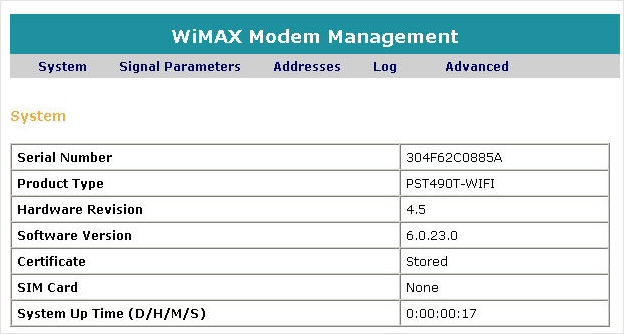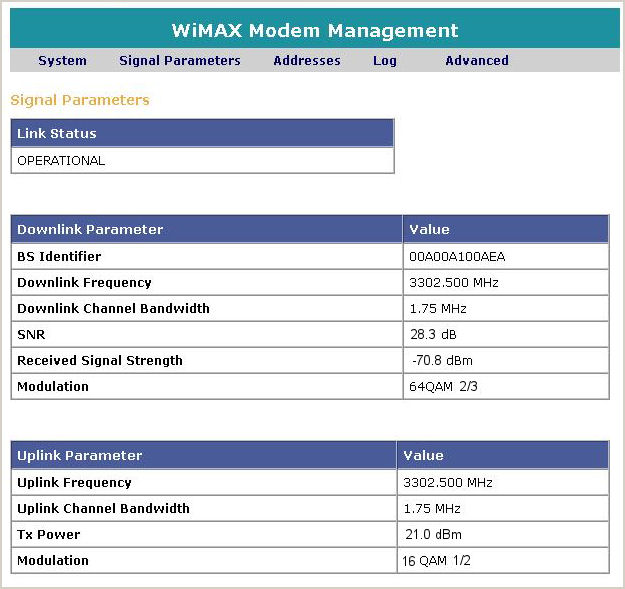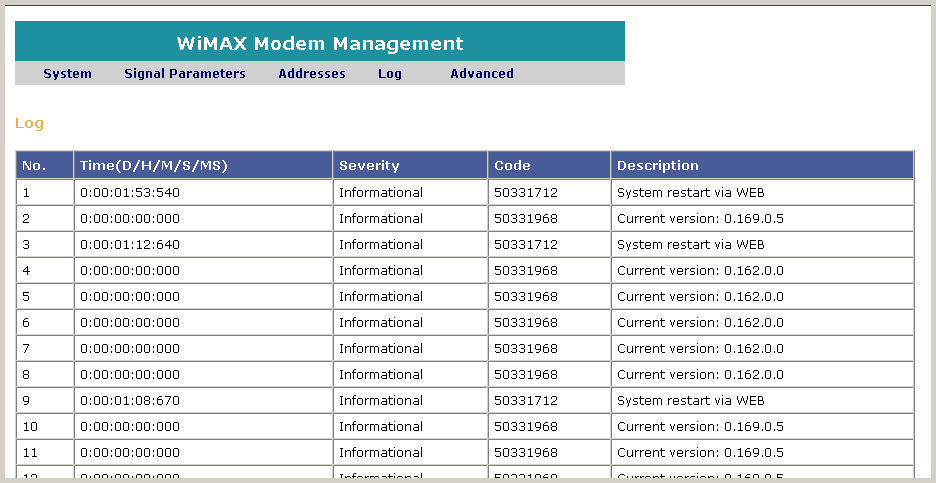 Note:
The following screens are for illustrational purposes only. Each product
type and revision will display its specific information.
Note:
The following screens are for illustrational purposes only. Each product
type and revision will display its specific information.The WBM allows you to view configuration parameters pertaining to the following categories:
Click on the specific parameter to access that parameter.
 Note:
The following screens are for illustrational purposes only. Each product
type and revision will display its specific information.
Note:
The following screens are for illustrational purposes only. Each product
type and revision will display its specific information.
The EasyST/ProST system information is displayed in the System page, which is accessed from the System menu. The System page displays a table containing read-only system information, as displayed below.

The parameters of the System page are described in the table below:
|
Parameter |
Description |
|
Serial Number |
EasyST/ProST serial number |
|
Product Type |
Type of product (i.e. EasyST or ProST) |
|
Hardware Revision |
EasyST/ProST hardware revision |
|
Software Version |
EasyST/ProST currently active software version |
|
Certificate |
Digital certificate (x.509) indication either, stored or not
|
|
SIM Card |
Displays whether a SIM card is installed (EasyST only) |
|
System Up Time (D/H/M/S) |
How long the system is running since the last reset in Days, Hours, Minutes and Seconds |
The Signal Parameters menu opens the Signal Parameters page (see figure below), which displays various signaling parameters. This page displays: the link status, a table containing downlink parameters (BS TRx to EasyST/ProST), and a table containing uplink parameters (EasyST/ProST to BS TRx).

The parameters of the Signal Parameters are described in the table below
|
Parameter |
Description | |
|
Link Status |
Actual WiMAX Link States |
Initialization Phases, either: |
| ||
| ||
| ||
| ||
| ||
| ||
| ||
| ||
| ||
| ||
|
Downlink |
BS Identifier |
BS TRx ID number that the SS is presently connected to |
|
Downlink Frequency |
Frequency used for downlink transmission (in MHz) | |
|
Downlink Channel Bandwidth |
Downlink frequency bandwidth (in MHz) | |
|
SNR |
Signal-to-noise ratio (in dB) | |
|
Received Signal Strength |
Received signal strength at EasyST/ProST (in dBm) | |
|
Modulation |
Modulation scheme available to the SS (e.g. 16 QAM 1/2) | |
|
Uplink |
Uplink Frequency |
Frequency used for uplink transmission (in MHz) |
|
Uplink Channel Bandwidth |
Uplink frequency bandwidth (in MHz) | |
|
Tx Power |
Transmit power of EasyST/ProST (in dBm) | |
|
Modulation |
Reports on which modulation of the last data stream | |
The Addresses menu opens the Addresses page (see figure below), displaying various IP addresses as well as MAC addresses "learned" (listed in the MAC Table) .

The parameters of the Addresses table are described in the table below:
|
Parameter |
Description |
|
MAC Address #1 |
Ethernet media access control (MAC) address of the device (i.e. EasyST/ProST) |
|
MAC Address #2 |
Ethernet media access control (MAC) address of the 2nd device (for future release) |
|
LAN Port Default IP Address |
IP address of device's LAN port (default value is 10.0.0.1) |
|
Default Subnet Mask |
Default subnet mask address |
|
IP Address (via DHCP) |
Device's IP address assigned by Dynamic Host Configuration Protocol (DHCP), when set to DHCP, see IP Mode Settings |
|
IP Mask (via DHCP) |
Subnet mask address assigned by DHCP, when set to DHCP, see IP Mode Settings |
|
Default GW (via DHCP) |
Default gateway address assigned by DHCP, when set to DHCP, see IP Mode Settings |
|
DHCP Server IP Address |
IP address of DHCP server, when set to DHCP, see IP Mode Settings |
|
IP Address (static) |
Device's IP address set manually, see IP Mode Settings |
|
IP Mask (static) |
Subnet mask address, see IP Mode Settings |
|
Default GW (statis) |
Default gateway address, see IP Mode Settings |
|
DHCP Server IP Address |
N/A in Static mode |
The fields of the MAC Table are described in the table below:
|
Parameter |
Description |
|
Index |
place identifier |
|
MAC Address |
Ethernet media access control (MAC) address of the devices connect via LAN |
|
Status |
Learned = dynamic or static, for example: dynamically learned MAC on static, this MAC address was assigned as a Static entity in the MAC table. |
WiMAXWeb logs traps and events generated by and received from the EasyST/ProST. The information logged parameters are displayed in the Log page via the Log menu, as displayed below:

The fields of the Log are described in the table below:
|
Parameter |
Description |
|
No. |
Trap identification number |
|
Time |
Time (in Days, Hours, Minutes, Seconds and Milliseconds) since power up, when the particular event was generated |
|
Severity |
Informational |
|
Code |
Unique event code |
|
Description |
Brief description of trap or event |